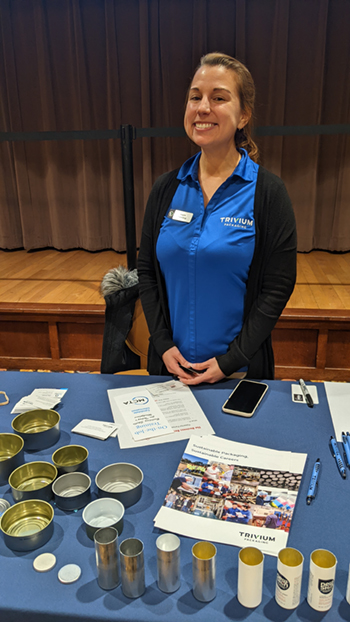YOUNGSTOWN, Ohio – As companies struggle to hire, concerning themselves with headcount and just getting people in the door, effective onboarding strategies might be put on the back burner.
Human resources professionals caution employers, however, about lacking an onboarding strategy. The first few days on the job can go a long way toward retaining new hires as longterm employees and allowing them to succeed in their careers.
“We have a workforce that has options. They have other jobs that they can consider,” says Kimberly Pleva, senior lecturer in the department of management and marketing at the Williamson College of Business Administration at Youngstown State University. “They’re looking for employers that will value them and they feel a strong connection with them.”
Establishing that personal relationship begins early in the recruiting process and carries over to onboarding, Pleva says.
Throughout the process, employers should be discussing company values and culture with the individual to ensure they are a good fit and that the job matches what they seek.
Unfortunately, companies are struggling to hire right now. So some employers are forgoing a long-term onboarding process in favor of a quick orientation just to get people in the door. That may include filling out paperwork, background checks or other types of testing.
It also comes down to the time an employer’s HR department has to spend on onboarding. While an orientation may take anywhere from a few hours to a few days, a true onboarding process can take three months, even a year, to fully integrate a new hire into an organization, Pleva says.
When done correctly, an onboarding process can lower the turnover rate of a company, increase its retention, build employee loyalty and improve overall productivity, she says.
“We’re hearing about the Great Resignation and all of that. [Employees] just want to feel like they’re important and an organization cares about them,” she says. “If we can build that into our onboarding process and build relationships that way, that’s critical to this process.”
In a competitive market, personalization can sometimes be overlooked, agrees Christopher Allen, HR manager at Ultium Cells LLC. Any onboarding strategies that don’t treat people as individuals or take the time to get to know the new hires should be avoided, he says.
New hires participate in a values workshop at Ultium, which becomes the basis for learning and growth within that company, he says. Days two and three cover battery cell manufacturing, what the products are used for and the specifics of each department.
Most new hires don’t expect that and are surprised by the approach, Allen says.
“It’s not a traditional way of being indoctrinated into a company,” he says. “We’re establishing what we expect from our employees, and what we want our employees to exhibit throughout their work time while they’re with us.”
Most Ultium employees are very receptive to the strategy, he says. At least one of the new hires each week asks Allen why it’s taken this approach instead of a typical orientation, he says.
“It’s because we want to make sure that you understand that this is really important to us to establish culture in the greater workplace that’s comfortable for everybody,” he says.

Overall, employers should be as engaging as possible with the new hires during onboarding and orientation, says Kayla Panning, talent acquisition manager for Trivium Packaging.
Having a team leader talking at new hires for hours isn’t as effective as having him engage the individuals during the orientation process and get them moving, she says.
“Walk them around. Show them what’s going on,” she says. “Just really make sure that you’re immersing them into the culture from Day One.”
Panning recommends companies provide new hires with an onboarding itinerary ahead of time so they know what to expect and are prepared. That shows the company is ready for them to come aboard and has a plan on how they will spend their first few days, up to and including who will be training them.
She also says employers should clearly communicate to new hires what they need to bring to the job and communicate the company’s expectations of them while on the job, she says.
“Gone are the days where somebody’s excited about a job and they can just show up at 8 o’clock in the morning and they have no idea how their day’s going to go,” she says.
When onboarding new hires, Panning ensures they know they can reach out to her with questions or concerns as they begin their new jobs. She provides them with a business card and an open-door policy.
“I’m here as a resource,” she says. “Not just as somebody who’s here for your first couple hours and then never to be seen again.”
Panning recommends employers keep the other elements of onboarding simple.
Today’s new hires don’t want to have to “jump through hoops” in terms of paperwork, she says. She recommends sending new hires tax forms and other needed documents to fill out at home and bring with them on the first day of their new jobs.
“If you can give them some documentation earlier digitally, that would help as well,” she says.
That kind of preboarding is more and more becoming a trend among employers, says YSU’s Pleva. Completing paperwork can be “exhausting, mind-numbing work. But, it needs to happen,” she says.
Allowing workers to take care of it ahead of time ensures they aren’t filling out forms for half of their first day on the job.
Once an employee is situated and expectations are set, opportunities for continual training and development are critical for retention, YSU’s Pleva says. That lends itself to the length of time it can take to fully onboard a new employee.
“Employees are looking to see, ‘OK, where is this job going to take me?’ ” she says. “They’re looking for career paths.”
One of the best practices might be to establish a mentoring program, or even a buddy system – someone who isn’t in the chain of authority who can help to guide employees through the organization and its culture.
Promoting career paths has been central to Ultium’s recruiting, Allen says. That covers workplace culture and benefits beyond just the rate of pay, such as tuition reimbursement, whether for college or trade schools.
Both recruiting and onboarding have become more targeted. The electric-vehicle battery manufacturer is heavily recruiting in high schools and talking to juniors and seniors about long-term career opportunities.
“You can’t expect to generally announce something and expect people to come. It doesn’t work that way anymore,” he says. “People want to know you.
“They want you to come out to them and they want you to talk about more than just the job.”
Trivium’s Panning agrees.
Recruiting outreach needs to encompass online, social media, newspapers and “almost doing a grassroots effort,”she says, by getting out into communities.
Being prepared and being able to pivot with one’s tactics is helpful. “Because what might work right now in the spring of 2022 might not work in the summer,” she says.
A good response to a job posting on Indeed gets 50 applicants, from which Trivium can hire a few qualified workers.
Depending on the time of year, however, applicants may be fewer. “So we might have to go somewhere else,” like a college or tech school, she says.
HR reps have to be intentional with their outreach, she says. Targeted messaging to particular platforms is important when trying to attract certain workers.
“What might work for getting a warehouse worker might not work if you’re looking for somebody in maintenance or somebody in finance,” she says.
Pictured: Christopher Allen is the human resources manager at Ultium Cells LLC. Nichole Noday is the HR recruiter.
